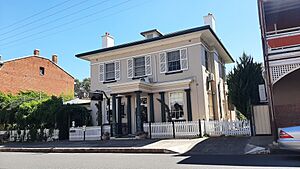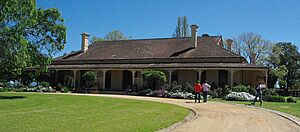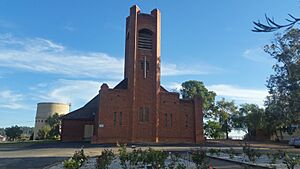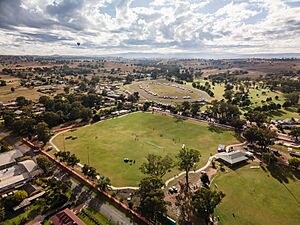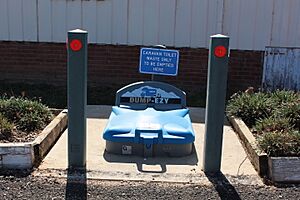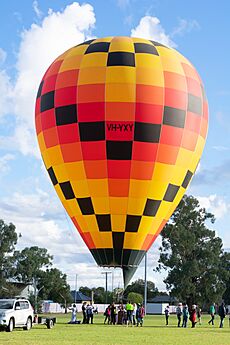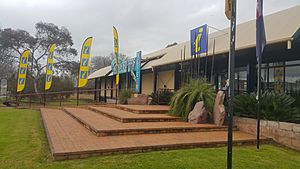Canowindra facts for kids
Quick facts for kids CanowindraNew South Wales |
|||||||||
|---|---|---|---|---|---|---|---|---|---|
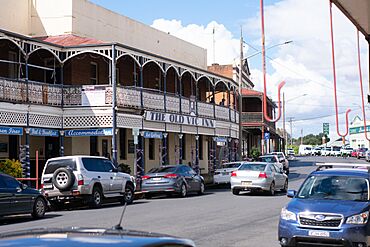 |
|||||||||
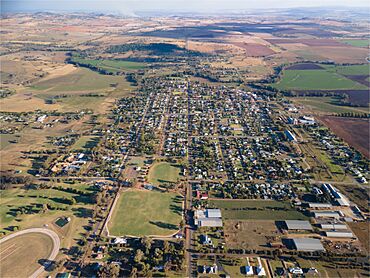
Main town of Canowindra (top). Aerial photo of the town (bottom).
|
|||||||||
| Population | 2,832 (2021 census) | ||||||||
| Established | 1847 | ||||||||
| Postcode(s) | 2804 | ||||||||
| Elevation | 300 m (984 ft) | ||||||||
| Location | |||||||||
| LGA(s) | Cabonne Shire | ||||||||
| State electorate(s) | Orange | ||||||||
| Federal Division(s) | Calare | ||||||||
|
|||||||||
Canowindra (pronounced kə-NOWN-drə) is a historic town in the central west of New South Wales, Australia. It sits on the Belubula River, between the towns of Orange and Cowra. Canowindra is the biggest town in Cabonne Shire. Its main street, Gaskill Street, curves through the town and is known for its old-world charm.
Contents
What's in a Name?
The name Canowindra comes from the Aboriginal Wiradjuri language. It means 'a home' or 'camping place'.
Canowindra's Past
For thousands of years before Europeans arrived, the Wiradjuri people lived in the Canowindra area. These "people of the three rivers" were skilled hunters and gatherers. They used the rivers and lands for food and resources.
How European Settlement Began
The first European land grant in the area was given to James Collits in 1829. He received 640 acres from Governor Ralph Darling. A small settlement slowly grew around this land. By 1844, the village was known as Canowindra.
A post office opened in Canowindra in 1847. The town's growth was slow at first. The first bridge over the Belubula River opened in 1875. It was later replaced by the Waddell Bridge in 1901, and then the current John Grant Bridge in 1997. Gold was also mined near Canowindra at places like Blue Jacket and Grant's Reef.
Bushrangers in Canowindra
Canowindra was visited by famous bushrangers several times in the 1860s. These were outlaws who lived in the Australian bush.
In September 1863, bushrangers John Gilbert and Ben Hall and their gang arrived in Canowindra. They took over the local pub and stores. They even held a dance that night! The bushrangers stayed for a fun night, then left before the police could catch them.
A few weeks later, in October 1863, Ben Hall, Gilbert, and John O'Meally returned. They held the town for three days and nights. They made everyone stay at William Robinson's public-house. The bushrangers paid for everyone's food and drinks. They even bought cigars and sweets for their "guests." They were waiting for a gold escort that never arrived. After three days, they left town.
The bushrangers returned again in November 1863 and June 1864. They continued to take supplies and money from the local stores.
Exploring Canowindra's Buildings
- Gaskill Street: This main street feels like stepping back in time. Its curving shape follows an old bullock team track. Many buildings here are protected as heritage sites.
- The Swinging Bridge: This special footbridge connects different parts of Canowindra. It was first built in 1938 and is known as the "Swinging Bridge." It has been made stronger over the years to handle floods.
- All Saints' Anglican Church: This beautiful brick church was designed by Louis Williams. It has unique stained glass windows, including one by Christian Waller.
- Noojee Lea: This historic homestead is located outside town on the Belubula River. It has large gardens designed by famous landscapers. The owners often open the gardens to the public to raise money for the local hospital.
- The Big Peg: Canowindra is home to one of Australia's big things! It's a giant clothes peg located just outside town.
Canowindra Today
How Many People Live Here?
Canowindra's population has grown over time. In 2021, about 2,832 people lived in the Canowindra postal area.
| Year | Population |
|---|---|
| 1866 | 120 |
| 1911 | 1,535 |
| 1947 | 2,271 |
| 2001 | 2,340 |
| 2021 | 2,832 |
Most people in Canowindra were born in Australia (88.2%). English is the main language spoken at home (91.5%).
Neighbourhoods
Canowindra has two main residential areas: South Canowindra and Moorbel.
- South Canowindra is a rural area south of the Bellubula River.
- Moorbel is a small area about 3 km east of Canowindra. It has a local market held each month.
Canowindra Hospital
The Canowindra Soldiers Memorial Hospital is located in Browns Avenue. It was built to remember the local men who served in World War I. The hospital opened in 1922. It provides health services, including emergency care.
Schools in Canowindra
Canowindra has three schools:
- Canowindra High School (Years 7–12)
- Canowindra Public School (Kindergarten–Year 6)
- St Edwards Primary School (Catholic, Kindergarten–Year 6)
There is also a pre-school for younger children.
Community Groups
Canowindra has many active community groups:
- The Lions Club helps the community.
- The Country Women's Association (CWA) was founded in 1924.
- A community garden is open to all residents and visitors.
- The Canowindra Services & Citizens Club offers facilities for members.
- The Canowindra Garden Club raises money for charity.
- The Canowindra Historical Society runs the Canowindra Historical Museum. It shows old tools, clothes, and photos from the town's past.
- The Canowindra Pastoral Agricultural and Horticultural Association organizes the annual show. This event has been held since 1900.
The Miracle House
In 2013, a local family with triplets who had special health needs received amazing support. The community raised money to build a special house for them. This house has features designed to help the family. In 2021, a hydrotherapy pool was added.
Arts and Music
- The Canowindra Fine Music Group holds an annual Baroque Music Festival. It features performances of old music.
- The CWA also hosts a "Sunday Serenade" at All Saints Church. This event shows off local talent and raises money for music scholarships for kids.
Sports and Fun
Canowindra has many sports clubs and facilities:
- Sports include Rugby league (Canowindra Tigers), Rugby union (Canowindra Pythons), Cricket (Canowindra Sixers), Tennis, Lawn Bowls, Squash, Golf, and Swimming.
- Younger kids can join a pony club or Little Athletics.
- The town has a sports oval called Tom Clyburn Oval. It has fitness stations, basketball courts, and skateboarding facilities.
- There's a nine-hole golf course.
- The local swimming pool is open from late spring to mid-autumn.
RV Friendly Town
Since 2016, Canowindra has been an "RV Friendly Town." This means it welcomes people traveling in campervans and motorhomes. It offers low-cost campsites, easy access to shops, water, and a free waste dump point.
Media
You can listen to many radio stations in Canowindra, including ABC Local Radio, Hit Network, and Triple J. The town also receives five free-to-air television networks. Internet service is available through the NBN.
Wineries
Canowindra is part of the Cowra wine region. There are eight wineries around the town. Some offer cellar door sales where you can taste their wines.
Other Interesting Places
The Royal Hotel is on the site of an old inn. It's believed to be where Ben Hall's bushranging gang had their famous stay. Other notable buildings include the Junction Hotel and the Victoria Hotel.
Hot Air Ballooning Capital
Canowindra is known as the Ballooning Capital of Australia!
In 1988, Canowindra hosted the Australian National Balloon Championships. Since then, it has hosted the championships many more times, including in 2011, 2013, and 2014.
The Canowindra International Balloon Challenge is Australia's biggest ballooning event. It happens every April. Pilots and balloons come from all over the world to compete. You can even watch the event live online!
A "balloon glow" is a popular part of the event. Balloons light up at night like giant lanterns. There's also a local food and wine market. The event ends with a "key grab," where pilots try to grab a large key from a tall pole.
Amazing Fossils
Canowindra is famous for one of the world's most important fossil discoveries! In 1956, a road worker found a large rock slab filled with 114 fish fossils. These fossils are over 360 million years old, from the Devonian period.
The fish were trapped and buried when a pool of water dried up. The slab shows many armored fish called Remigolepis walkeri and Bothriolepis yeungae. Other important fossils include Canowindra grossi, a large lobe-finned fish.
Today, you can see these amazing fossils at The Age of Fishes Museum in Canowindra. The original 1956 slab was returned to the museum in 2006. The famous naturalist Sir David Attenborough visited the museum in 2013. He called the fossil collection "world class."
NSW State Fossil Emblem
The official fossil emblem for New South Wales is Mandageria fairfaxi. This 370-million-year-old fossil fish was found in the Canowindra Fish Bed. It was named the state emblem in 2015.
Famous People from Canowindra
- Kath Anderson – a politician in New South Wales.
- Ron Boden – a rugby league player and coach.
- Col Buchanan – an Australian musician and entertainer.
- Lisa Corrigan – an Olympic athlete and Australian record holder.
- Stanley Drummond – a minister who helped build the Soldiers' Memorial Hospital.
- Hubert Clement 'Butt' Finn – a rugby league player and doctor.
- Julia Finn – a politician in New South Wales.
- Rhyan Grant – a professional footballer for Sydney FC and the Socceroos.
- Elwyn Lynn – an artist, author, and art critic.
- Alicia McCormack Smith – an Olympic water polo player who won medals.
- Rex Norman – a rugby league player and coach.
- Gordi (Sophie Payten) – a recording artist.
- Bishop Douglas Warren – a Roman Catholic bishop.



